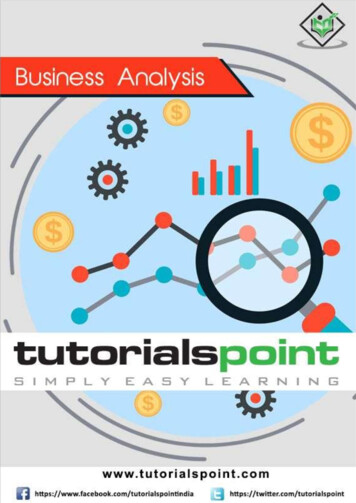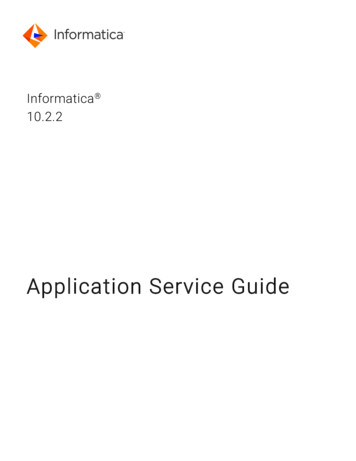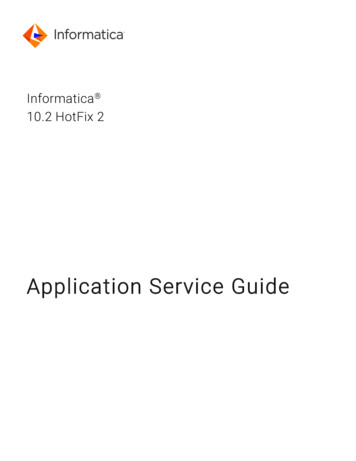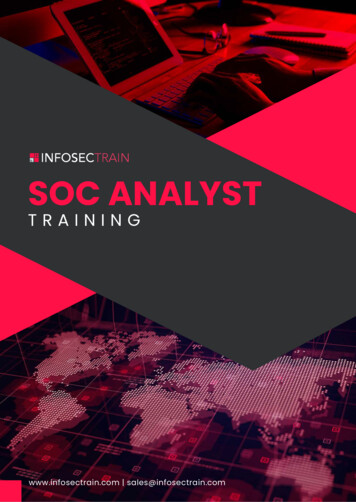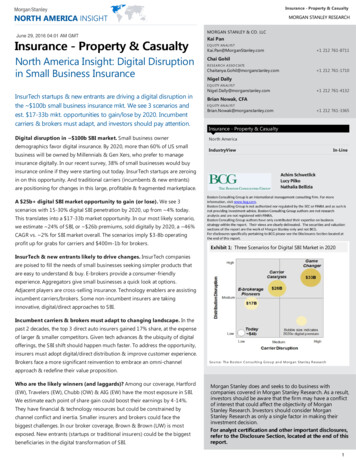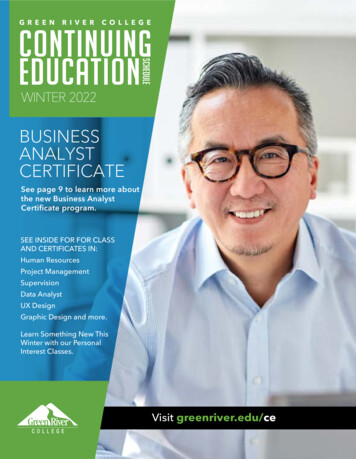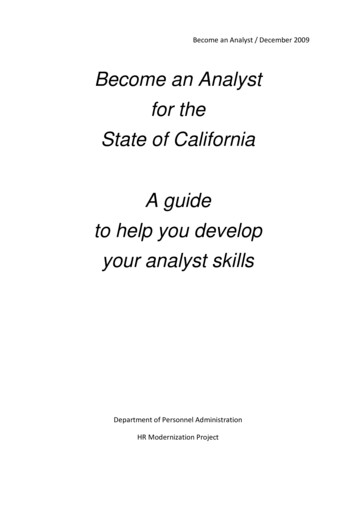
Transcription
Become an Analyst / December 2009Become an Analystfor theState of CaliforniaA guideto help you developyour analyst skillsDepartment of Personnel AdministrationHR Modernization Project
We thank these contributors:California Department of EducationBoard of EqualizationCounty of Santa Barbaraii
ContentsGetting started1If you're thinking about becoming an analystHow do I use this guide?11For supervisors1Use the employee's self-assessment1Tailor training to meet the employee’s needs2Self-assessment3Competencies3Analytical Thinking4Customer Focus5Oral Communication Skills6Written Communication Skills7Interpersonal Skills8Organizational Awareness9Personal and Professional DevelopmentAfter you take the self-assessment, it's time to talkTraining101112Choose the right course12Beyond formal training12For more information12Training providers12Training curriculum by competency14Analytical Thinking14Customer Focus18Oral Communication19Written Communications21Interpersonal Skills24Organizational Awareness26Professional and Personal Development27iii
Guidance for supervisors30How do I develop a good IDP?30Gauge the amount of guidance an employee needs30Talk with the employee30Refer to the IDP regularly30Evaluate performance every year30How can I help employees develop professionally?30Coach and mentor employees30Encourage self-development31Talk about training courses before and after31Be a good role model31Build the employee's relationships31Resources to help you give useful performance feedback31Guidance for employees33How can the IDP help me become an analyst?33Identify the gap33Set your objectives33Make a plan33How can I achieve my objectives?33Develop yourself through training33Stay motivated and keep going!34Notes35iv
Getting startedIf you're thinking about becoming an analystThis guide will help you: Assess yourselfIdentify the knowledge, skills, abilities, and personal characteristics(competencies) needed to become an analystIdentify training to help you develop these competenciesDiscuss your current job performance and upward mobility with yourmanagerDevelop your career plan to become an analystHow do I use this guide? Start by talking to your supervisor. Work together to fill out the selfassessment. Then work with your supervisor to identify the training you need.For supervisorsSupervisors can use this guide to develop a career plan with the employee. Werecommend you help the employee develop in ways that support yourdepartment's strategic goals.You'll find detailed advice on page 30.Use the employee's self-assessmentWe recommend you and your employee complete the assessment separately andthen meet to discuss one another’s perspectives. The self-assessment helps youdiscuss: Career development plansUpward mobility plansThe individual development plan and the performance appraisal summary(STD 637) - PDF. (This form, completed annually, is the primary method forevaluating the skill levels of BU 4 employees.)Also see the guidance at the end of this guide.1
Tailor training to meet the employee’s needsEmployees have different training needs, depending on their existing skills,knowledge, attitudes, experiences, responsibilities, and assignments. They havedifferent learning patterns and respond to different types of teaching. No singletype of training will work well for everyone preparing to become an analyst.2
Self-assessmentThe self-assessment helps clarify what's important in your current job,identify performance gaps, andshow you where you need to develop.We recommend you and your supervisor complete this form separately and thenmeet to discuss your perspectives. Work together to develop an individualdevelopment plan or upward mobility plan. You'll find samples on page Error!Bookmark not defined. (Sample IDP) and page Error! Bookmark not defined.(sample upward mobility plan).Use these scales as you take the self-assessment: Importance to current job: Critical, medium, or low.Needs more development: High need for training and development,refresher needed, or leave blank if training and development aren'tneeded.CompetenciesThis comprehensive self-evaluation identifies competencies you'll need to becomean analyst. You'll assess yourself in these key competencies: Analytical ThinkingCustomer FocusOral CommunicationWritten CommunicationInterpersonal SkillsOrganizational AwarenessProfessional And Personal DevelopmentFor each competency, we identify performance expectations. The expectationsapply to anyone wanting to become a State analyst. Specifically, they're consistentwith the job expectations negotiated for all employees of Bargaining Unit 4 (BU 4)and Bargaining Unit 1 (BU 1).For more on competencies, see the Competency -dictionary.htm).3
Analytical ThinkingPerformance ExpectionImportance toCurrent JobDevelops and evaluates logical alternatives tosolve routine problems.Analyzes data, discriminates between relevantand irrelevant data, and present ideas andinformation effectively.Reads routine correspondence or materials,simple charts, tables, graphs, and diagrams.Applies information to complete routine orsimple tasks.Visually organizes information to get a pointacross; determine the best way to effectivelypresent data so it will be understood.Gathers information from one or two sourcesidentified by others.Organizes and maintains routine informationusing clearly outlined guidelines.Follows up with staff work that is completeand ready for an appropriate decision.4Needs MoreDevelopment
Customer FocusPerformance ExpectionImportance toCurrent JobIdentifies customers and clients (internal andexternal) to identify what they want and todevelop staff work tailored to meet theirneeds.Clarifies customer and client needs andresolves conflicts in priorities where theyoccur.Establishes and maintains rapport withcustomers and clients and lets them knowhe/she is willing to work with them to meettheir needs.Solves customer problems quickly andeffectively.Finds ways to measure and track customersatisfaction.5Needs MoreDevelopment
Oral Communication SkillsPerformance ExpectationsImportance toCurrent JobOrganizes thoughts and ideas into a cogentand logical presentation.Ensures that others involved in a project oreffort, including the manager, is keptinformed about progress and problems.Consults with and advises administrators orother interested parties on a wide variety ofsubject-matter areas.Listens to others and responds appropriately.Presents ideas and information effectively.Facilitates productive meetings.6Needs MoreDevelopment
Written Communication SkillsPerformance ExpectationImportance toCurrent JobEffectively communicates the results ofhis/her work to others.Presents a logical, objective, and wellconsidered line of thought.Meets agency or departmental standardsfor grammar, punctuation, and spelling.Composes documents or correspondenceinvolving simple or routine information.Revises and edits his/her own work andseek help when necessary.Writes for tone, brevity, and effectivenessand proofreads own work.Avoids the use of jargon and bureaucraticterminology.7Needs MoreDevelopment
Interpersonal SkillsPerfomance ExpectationImportance toCurrent JobGains and maintains the confidence andcooperation of management, other employees,customers, or others contacted during thecourse of work.Remains courteous when discussinginformation or eliciting non-sensitive ornoncontroversial information from people whoare willing to give it.Effectively handles situations involving little orno tension, discomfort, hostility, or distress.Anticipates how others will react to a situation.8Needs MoreDevelopment
Organizational AwarenessPerformance ExpectationImportance toCurrent JobUnderstands principles, practices, and trendsof public and business administration,management, and supportive staff servicessuch as:BudgetingPersonnelManagement analysisContractingUnderstands governmental functions andorganization.Keeps current with issues which may have afuture impact on the mission of theorganization.Understands and effectively works within theorganization’s structure and policies.9Needs MoreDevelopment
Personal and Professional DevelopmentPerformance ExpectationIdentifies with his/her supervisor areas wheretraining may improve performance andenhance career goals.Maintains an open feedback loop with his/hersupervisor regarding performance goals.Builds on strengths and addressesweaknesses.Seeks out new learning experiences andopportunities to master new knowledge.Takes advantage of professional developmentopportunities.Develops an Individual Development Plan as afollow-up to the performance evaluationprocess.10Importance toCurrent JobNeeds MoreDevelopment
After you take the self-assessment, it's time to talkTalk with your supervisor about the areas critical to your current job that also showa high need for training and development. Make these your immediate trainingpriorities, since they help improve current performance as well as help prepare youfor an analyst position.Work together to develop an individual development plan or upward mobility plan.You'll find samples on page Error! Bookmark not defined. (Sample IDP) and pageError! Bookmark not defined. (sample upward mobility plan).11
TrainingChoose the right courseFor each competency, we list courses that will help develop that competency.We recommend you look for courses that assess knowledge and skills before andafter training. That kind of assessment ensures the course is effective and that theskills are put to use back on the job.You can take many courses over the Web. The California Virtual Campus can helpyou find online courses in several subject areas (http://www.cvc.edu).We encourage all State employees to enhance their skill sets and careeropportunities. However, time and monetary reimbursement depend on yourdepartment's operation needs and funding, and on your bargaining unit contract.Beyond formal trainingYou can also develop your analyst competencies through: ApprenticeshipsCommunities of practiceExpert interviewsInternshipsJob aidsJob shadowingMentoringStorytellingStructured on-the-job trainingFor more informationPlease contact Jodi Traversaro (916) 324-3860 or joditraversaro@dpa.ca.gov orJoan Strohauer (916) 558-1812 or joanstrohauer@dpa.ca.govTraining providersWe list only a few training providers here. Other departments, colleges, andtraining providers may offer the same or equivalent courses.12
We recommend each department supplement this list by adding internal classesand other training providers. For departments that print this handbook, we've leftspace to add more providers and courses.Cooperative Personnel Services (CPS)Attn: Training Center241 Lathrop WaySacramento, CA 95815(916) 263-3614 Option 3TrainingCenter@cps.ca.govCalifornia State University, Sacramento/College of Continuing Education(CSUS/CCE)3000 State University Drive EastSacramento, CA 95819-6103Phone: (916) 278-4433; (800) 858-7743http://www.cce.csus.edu/Department of Technology Services (DTS)P.O. Box 1810Rancho Cordova, CA95741-1810(916) 464-7547www.dts.ca.gov/trainingState Personnel Board (SPB)801 Capitol MallSacramento, CA 95814(916) 653-1705http://www.spb.ca.govUniversity California of Davis Extension (UCD)1333 Research Park DriveDavis, CA 95618(800) 752-0881(530) 757-8777http://extension.ucdavis.edu/index.aspLos Rios Community College District, Government Training Academy(LRCCD/GTA)1410 Ethan WaySacramento, California 95825-2205(916) 563-3230http://www.trainingsource.losrios.edu/13
Training curriculum by competencyAnalytical ThinkingDefinition: Approaching a problem using a logical, systematic, sequentialapproach; conducts completed staff workExpectations Develop and evaluate logical alternatives to solve routine problems.Analyze data; discriminate between relevant and irrelevant data, andpresent ideas and information effectively.Read routine correspondence or materials, simple charts, tables, graphs,and diagrams; apply information to complete routine or simple tasks.Visually organize information to get a point across; determine the best wayto effectively present data so it will be understood.Gather information from one or two sources identified by others.Organize and maintain routine information using clearly outlinedguidelines.Follow up with staff work that is complete and ready for an appropriatedecision.Training curriculumEach course may not meet all expectations listed above.Communicating with Data helps participants present numerical data to managers,decision makers, or the general public so they can readily understand the data.Participants will learn concepts, conventions, and mechanics behind the effectiveuse of tables, charts, and graphs and practice using them. (CPS, 8 hrs.)Introduction to Completed Staff Work is about identifying competencies neededfor Completed Staff Work (CSW) and becoming familiar with the basics of theseven-step CSW and problem solving models. This is accomplished throughinstruction and individual and group practice on problems and scenarios presentedby the instructor. It may be considered an upward mobility course to provideemployees with an opportunity to prepare for more challenging positions. (SPB, 8hrs.)Completed Staff Work will prepare participants to effectively recommendsolutions to management problems. The process results in a product that willrequire only the manager’s signature to implement recommendations. Identifybarriers/problems that may be encountered in doing staff work and alternativesolutions to overcoming those barriers, identify factors to consider when preparing14
a recommendation, demonstrate a seven-step approach in analyzing a practical,work-related case, and prepare written recommendation using the “action memo”format. (CPS, 16 hrs.)Completed Staff Work is designed to provide participants with a thoroughunderstanding of the concepts of Completed Staff Work (CSW) and an opportunityto experience working on analytical problems individually and in teams using theseven-step CSW model. It is designed to provide participants with practice oncreating evaluation criteria, analyzing and evaluating alternatives, and preparingrecommendations for implementation based on generally accepted standards forgovernment agencies. (SPB, 16 hrs.)Introduction to Analytical Staff Work helps participants understand the role of theanalyst and the basic skills required. Participants will have the opportunity toperform assignments typical to government analysts, assess interest and skill levelin performing analytical work, and build knowledge and confidence to advancewithin government services. Learners will be able to list the seven steps ofsystematic analysis, apply spreadsheet methodology, design data collection survey,and recognize different data and their application and report formats. (CPS, 16hrs.)Overview of Analytical Skills will provide an overview of the fundamental skills andcompetencies necessary for success as an analyst. (CSUS/CCE, 4 hrs.)Introduction to Analytical Skills will help you understand the role of the analystand the basic skills required. It will also give you an opportunity practiceassignments often given to State analysts. You will also be able to assess yourinterest and skill level in performing analytical work. Participants will recognizevarious types of data, diagnose issues through data analysis, understand thedynamics, recognize commonly used report formats, and use systematic analyticalstrategies. (SPB, 16 hrs.)Developing Analytical Skills provides participants with hands-on experienceperforming analytical work, including: project work plans, gathering and analyzingdata, preparing an issue paper and making an oral presentation of findings andrecommendations. (CPS, 40 hrs.)15
Training curriculum, continuedFundamentals of Business Analysis - Develop the knowledge and skills you need tosucceed as a business analyst and enhance your ability to create solutions tobusiness problems. Explore the fundamentals of business analysis using theInternational Institute of Business Analysis's(R) (IIBA(R)) Business Analysis Body ofKnowledge (BABOK(R)). Learn the techniques, methodologies and corecompetencies required of effective business analysts. Explore best practices,strategies, needs and opportunities, system requirements, and the implementationand operational support of business solutions. (UCD, online.)Introduction to Critical Thinking covers concepts and methods central to soundcritical thinking. It provides skills useful to pre-analysts during problemidentification, identifying and evaluating alternatives, and other steps in theproblem solving process. (CPS, 16 hrs.)Critical Thinking is designed to help participants learn how to apply critical thinkingprinciples to address day-to-day problems with an easy to use problem solvingprocess. This is an experiential course. Includes activities with case studies,scenarios, problem solving and exercises to practice using new skills. (DTS, 8 hrs.)Critical Thinking Skills will provide participants with the definitions and variouscomponents that contribute to problem solving, creative solutions, and logicalargument. This hands-on approach addresses the processes and applications of thecritical thinking skills required in a professional environment. (CSUS/CCE, 16 hrs.)Critical Thinking Skills provides participants with information and methods to helpanalyze policies, evaluate documents, filter information, and solve problems.Participants will be able to analyze various situations, identify central issues in acomplex document, identity valid sources of information and expertise, solveproblems systematically, understand and explain the dimensions of a problem, andapply critical thinking model to a realistic organization problem. (SPB, 8 hrs.)Productive Thinking Workshop will introduce you to the essential principles of anew and powerful thinking methodology. You will understand the keys to unlockyour natural productive intelligence and unblock your thinking. You’ll learn andapply the skills you need to develop your untapped thinking capacity to solveproblems, discover opportunities, and implement solutions. Learn to recognize andovercome the three most common barriers to thinking more productively and howto break the unproductive thinking patterns holding you back. (CPS, 8 hrs.)Introduction to Project Planning for Pre-Analysts - As the world of work becomesmore collaborative; employees in state government are increasingly involved asteam leaders and members for projects large and small. In order to advance to therole of analyst, one must develop good team membership and leadership skills.16
The most effective way to ensure the success of any project, whether simple orcomplex is to plan it well at the outset. In this highly interactive course, you willalso receive a comprehensive set of tools to aid in project planning. This step-bystep course introduces a logical, powerful, and integrated project planningmethodology to participants who have no project management experience. (SPB, 8hrs.)Problem Solving and Decision Making provides realistic experiences that allow youto integrate and apply skills in group planning, problem solving, decision making,and facilitating positive group behaviors and processes. Participants will learn todefine a problem, write a clear problem statement, distinguish between terms,utilize consensus-seeking techniques, use basic data collection tools andtechniques, develop an action plan and use basic project scheduling andmonitoring tools and techniques, describe a process for making ethical decisions,present four effective formats for communicating and selling ideas, and transfertraining content and process into the daily work environment. (CPS, 32 hrs.)Internal classes or classes offered by other providers:17
Customer FocusDefinition: Identifying and responding to current and future client needs; providingexcellent service to internal and external clientsExpectations Identify customers and clients (internal and external) to find out what theywant and develop staff work tailored to meet their needs.Clarify customer and client underlying needs and resolve conflicts inpriorities where they occur.Establish and maintain rapport with clients and customers and let themknow he/she is willing to work with them to meet their needs.Solve customer problems quickly and effectively.Find ways to measure and track customer satisfaction.Training curriculumEach course may not meet all expectations listed above.Customer Service Excellence builds people skills and identifies critical issuesnecessary to improve customer relations. (CPS, 8 hrs.)Fundamentals of Customer Service teaches participants to define customerservice; the role of customer service in business; discusses the types ofcustomers/value of a customer; and the goal of customer service. (This class, aswell as other customer service classes, is offered by LRCCD/GTA as custom, inhouse courses for any state agency. Prices vary depending on length.)Internal classes or classes offered by other providers:18
Oral CommunicationDefinition: Listens to others and communicates in an effective mannerExpectations Organize thoughts and ideas into a cogent and logical presentation.Ensure that others involved in a project or effort, including the manager, iskept informed about progress and problems.Consult with and advise administrators or other interested parties on awide variety of subject-matter areas.Listen to others and responds appropriately.Present ideas and information effectively.Facilitate productive meetings.Training curriculumEach course may not meet all expectations listed above.Communicating Effectively helps participants improve oral communication skills,increase their ability to understand and be understood, and gain more influence.Participants will be able to communicate clearly by using appropriate non-verbalbehavior, listen effectively, and assess the effects of different communicationstyles. (CPS, 8 hrs.)Effective Communication allows participants to learn highly effectivecommunication skills including how to convey information so that the listenerclearly understands; allow the listener to make informed choices; show empathy insituation requiring sensitivity; confront in a professional manner when necessary.This is a highly interactive course with activities that include challenging scenarios,problem solving and exercises to practice using the new skills, and in-depthdiscussions in breakout groups to develop and articulate understanding ofconcepts. (DTS, 8 hrs.)Enhancing Communication in the Workplace allows participants to identifypersonal characteristics of the people they work well with and identify those stylesthat cause them confusion and difficulty. Participants will discover four primarycommunication behavioral styles used by individuals in the workplace and exploretheir own style preferences. Helpful suggestions are provided to manage diversestyle and talents and to create a more inclusive workforce. (SPB, 8 hrs.)Effective Listening helps participants pay better attention to communication andretain more information by closing the communication loop, overcoming listeningbarriers, exercising choices as a listener, listening non-verbally, establishingrapport, and defusing hostility. (CPS, 8 hrs.)19
Effective Presentations enables participants to practice techniques, receive specialcoaching and deliver two presentations in a supportive and encouragingenvironment. The course focuses on preparation, using audio-visual aids, buildingconfidence, analyzing an audience, establishing rapport, responding to questions,using effective platform techniques, and practicing relaxation. (CPS, 16 hrs.)Listening Skills will help participants understand why "listening" is critical to thecommunication process and the most important communication skill to learn;learn how to be an engaged, thoughtful, active listener; enhance understanding ofthe speaker's message; complete an assessment tool, and develop a personalaction plan for enhancing individual listening skills. (DTS, 8 hrs.)Presentation Skills for Analysts enables participants to apply adult learningprinciples to presentation preparation and delivery; use methods for engaging anaudience and keeping it interested; handle nerves and hostility more effectively;identify and practice verbal and nonverbal elements of effective delivery style;overcome common presentation blunders. (SPB, 16 hrs.)Conducting Effective Meetings is for team leaders, supervisors, project managers,and anyone else leading meetings at work. Participants will learn how to plan andstart meetings, keep things going, clarify roles, facilitate, and work with difficultattendees. This class helps you make good use of meeting time, be clear about howdecisions are being made, and leave meetings knowing that time was used well.(CPS, 8 hrs.)Meetings that Produce Results will give confidence to any person to run a meetingbetter, whether leading or attending. Participants will learn all the components ofa good meeting, how to prepare a meeting contract, how to deal with challengingpeople, how to build consensus, and how to organize a meeting using a seven-stepproblem solving process. The practicalities of writing on flip charts and how to dealwith panic as an inexperienced facilitator will be covered. (CPS, 16 hrs.)Internal classes or classes offered by other providers:20
Written CommunicationsDefinition: Ability to communicate simple ideas, thoughts and facts in writing;ability to use correct grammar, correct spelling, sentence and document structure,accepted document formattingExpectations Effectively communicate the results of his/her work to others.Present a logical, objective and well-considered line of thought.Meet agency or departmental standards for grammar, punctuation, andspelling.Compose documents or correspondence involving simple or routineinformation.Revise and edit his/her own work and seek help when necessary.Write for tone, brevity and effectiveness and proofread one’s own work.Avoid the use of jargon and bureaucratic terminology.Training curriculumEach course may not meet all expectations listed above.E-Communication Workshop - Most e-mails are sent with little editing orstructure, creating confusion and multiple problems. Fortunately or unfortunately,it becomes a permanent record, with your name or department’s name attached.This workshop provides tools to help the participant create clear and informativee-messages by improving the planning, writing, and editing processes. (CPS, 8 hrs.)Grammar – This program will debunk confusing myths about language and giveyou confidence in your ability to use and explain grammar, punctuation, and usagerules. It will help participants apply contemporary rules for sentence construction,capitalization, writing, usage standards, punctuation, and more. (CPS, 24 hrs.)Grammar & Punctuation Brush-Up – This program reviews the basics of grammar,with a focus on sentence structure and syntax. As we identify and correct commongrammar and punctuation errors, participants will become informed drafters,making changes to their own documents as well as to those of others not because“it sounds better,” but because they know the rules. (CPS, 8 hrs.)Information Mapping is designed to provide the analytical and organizationaltechniques needed to develop concise, easy to read memos, reports, and otherbusiness communications that convey key information clearly and generateexpected results. (CPS, 16 hrs.)Plain Language Writing introduces tips and techniques to improve clarity throughplain English. California State government agencies are mandated by California21
Government Code section 6219, to “write each document in plain,straightforward language, avoiding technical terms as much as possible, and usinga coherent and easily readable style.” Debunk myths surrounding governmentwriting, identify and use plain language, establish criteria for clear writing, editclarity without compromising accuracy, and recognize and revise bureaucraticstyle. (CPS, 4 hrs.)Effective Writing – Administrative writing assists participants to overcome the fearof writing (especially for another’s signature), organize thoughts, and communicateusing clear concise language. Participants will be able to create business-like andprofessional documents and identify and edit for clichés, bureaucratic jargon, andwordiness. (CPS, 16 hrs.)Writing Letters & Memos enables participants to identify reader and writer needs,select an appropriate tone and style for different audiences, get started byovercoming writer’s block, edit for clarity and efficiency and designcorrespondence for visual interest and emphasis. (CPS, 8 hr.)Writing Style Tips enhances clarity and concision in work documents. Learn todraft readable, professional documents from the bottom up by crafting crisp, clearsentences in plain English. Appropriate for business and technical writers. Solidunderstanding of grammar recommended. (CPS, 8 hrs.)Introduction to Writing for Analysts teaches participants how to become morecompetent and confident writers. Using the WRITE method, the course provides aclear and painless way to prepare, generate ideas, and produce an orderlydocument. Participants will be able to eliminate jargon, “bureaucratese,” andwordiness; utilize plain language; understand and utilize the active voice; writeconcise, yet complete documents; utilize parallel structure and other consistencytips; employ graphics when and where appropriate; analyze your audience andpurpose for writing; organize and edit content for clarity, conciseness, andcorrectness. (SPB, 8 hrs.)Writing Skills for Analysts helps make improvement in writing skills using thebuilding blocks for successful report writing. This course tea
Become an Analyst / December 2009 Become an Analyst for the . State of California . A guide . to help you develop . you
